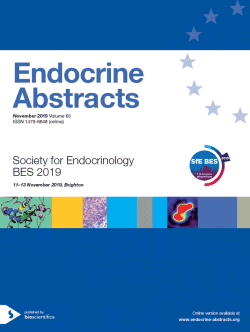
Society for Endocrinology BES 2019
Brighton,
United Kingdom
11 Nov 2019 - 13 Nov 2019

ORAL COMMUNICATIONS
Neuroendocrinology, Pituitary and Neoplasia
ea0065oc2.1 | Neuroendocrinology, Pituitary and Neoplasia | SFEBES2019
Differential effects of subcutaneous pulsatile versus oral hydrocortisone replacement therapy on fMRI resting state and task based emotional processing in patients with primary adrenal insufficiency
Russell Georgina , Kalafatakis Konstantinos , Thakrar Jamie , Hudson Elizabeth , Alim Lina , Marchant Nicola , Thirard Russell , Brooks Jonathan , Thai Jade , Harmer Catherine , Lightman Stafford
ea0065oc2.2 | Neuroendocrinology, Pituitary and Neoplasia | SFEBES2019
Investigating the role of AIP in pituitary tumourigenesis
Mistry Anisha , Solomou Antonia , Vignola Maria Lillina , Lim Chung Thong , Herincs Maria , Caimari Francisca , Costa Alejandro Ibanez , Begalli Federica , Gualtieri Angelica , Roncaroli Federico , Rizzoti Karine , Gaston-Massuet Carles , Korbonits Marta
ea0065oc2.3 | Neuroendocrinology, Pituitary and Neoplasia | SFEBES2019
ErbB receptor signalling in MCF7 breast cancer cells: an information theoretic approach
Pope Robert JP , Welsh Gavin I , Coward Richard J M , McArdle Craig A
ea0065oc2.4 | Neuroendocrinology, Pituitary and Neoplasia | SFEBES2019
Investigating the role of vagal Y2R in PYY3-36-mediated appetite suppression
Alonso Aldara Martin , Cork Simon C , Ma Yue , Herzog Herbert , Bloom Stephen R , Distaso Walter , Murphy Kevin G , Salem Victoria
ea0065oc2.5 | Neuroendocrinology, Pituitary and Neoplasia | SFEBES2019
Efnb2 controls pituitary gland development by regulating proliferation of the pituitary stem/progenitor cells and EMT within the pituitary stem cell niche
Gualtieri Angelica , Nicholson James , Tan Rachael , Jimenez Fernando , Dattani Mehul , Guasti Leonardo , Gaston-Massuet Carles
ea0065oc2.6 | Neuroendocrinology, Pituitary and Neoplasia | SFEBES2019
Post-operative copeptin analysis as a predictor of diabetes insipidus after pituitary surgery
Rostom Hussam , Noronha Sean , Jafar-Mohammadi Bahram , Halliday Jane , Cudlip Simon , James Tim , Guha Nishan , Shine Brian , Pal Aparna



